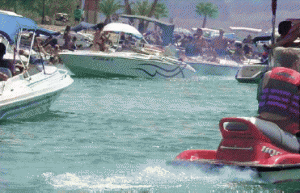Workplace Medical Mystery Solved: Water Patrol Deputy Gets Sick Out on the Lake
Posted on by Jim worked as a water patrol deputy for the county sheriff’s office. While working a 10-hour shift in the hot sun over a busy holiday weekend he began to feel sick. It started with a headache while he was working in a channel where hundreds of boaters congregate for a floating party. He then became dizzy and started to slur his speech. Jim’s patrol partner rushed him to the shore where medics took him to the hospital. Read more about his case here.
Jim worked as a water patrol deputy for the county sheriff’s office. While working a 10-hour shift in the hot sun over a busy holiday weekend he began to feel sick. It started with a headache while he was working in a channel where hundreds of boaters congregate for a floating party. He then became dizzy and started to slur his speech. Jim’s patrol partner rushed him to the shore where medics took him to the hospital. Read more about his case here.
At first it seemed Jim may be suffering from heat exhaustion, however, his slurred speech indicated something more severe. While his symptoms were consistent with heat exhaustion, emergency department staff also tested a sample of Jim’s blood for carboxyhemoglobin (COHb), a marker of carbon monoxide exposure, after learning that he had been on a boat for most of the day. Test results indicated Jim was suffering from carbon monoxide poisoning with a COHb concentration of 20%.
Carboxyhemoglobin is a substance made in your blood when hemoglobin, a part of red blood cells, binds with carbon monoxide instead of oxygen. Concentrations of COHb greater than 15% can be potentially toxic. Smoking tobacco increases the amount of CO in the blood so smokers are at greater risk of CO poisoning when exposed to another source of CO, such as potentially elevated CO levels in the channel that day, which may have been caused by excessive boat traffic.

Jim was given 100% oxygen through a facemask placed over his nose and mouth and will make a full recovery.
Carbon monoxide is a colorless and odorless gas that can poison or kill someone who breathes too much of it. It is produced any time a fossil fuel is burned. Gasoline-powered engines on boats, including onboard generators, produce CO. Traveling at slow speeds or idling in the water can cause CO to build up in a boat’s cabin, cockpit, bridge, and aft deck, or in an open area. The most common symptoms of CO poisoning are headache, dizziness, weakness, nausea, vomiting, chest pain, and confusion. High levels of CO inhalation can cause death. If near water, such as on a boat, CO poisoning can also cause a person to pass out and fall into the water and drown.
Some steps that could be taken to reduce the health hazard for the water patrol unit employees in this fictional account include:
- Determine what actions could be taken to reduce overall CO concentrations within an area where concentrations are found to be high, thus reducing the potential for employee over-exposure. Measures might include limiting the number of boats in certain areas or enforcing a “no idle” policy when boats are stationary.
- Employees assigned to duty on boats should receive training about the health effects of CO, how to recognize symptoms of CO poisoning in themselves and co-workers and work-practices that can reduce exposure to vehicle and boat exhaust.
- In areas where CO concentrations are determined to be elevated, until the CO concentrations can be reduced, employee assignments should be rotated periodically to areas where CO exposure does not occur.
- An employee exposure monitoring program can be developed to determine patterns of overexposure for employees (i.e., are they overexposed only on warm-weather holiday weekends, or at other times or during certain job tasks) and to ensure that control measures such as assignment rotation, or reduction of CO concentrations within an area with excessive CO concentrations, are effective.
- Employees should be encouraged to report symptoms of CO poisoning to designated health and safety personnel and should be provided with appropriate medical evaluation of symptoms.
Visit the NIOSH website for more information on how to prevent CO poisoning on boats.
Stephanie Stevens, MA, is a Health Communication Specialist in the NIOSH Office of the Director.
Workplace Medical Mysteries are fictional, however, they are loosely based on Health Hazard Evaluations (HHE) conducted by NIOSH or other reports by NIOSH and other sources, and any recommendations made herein were for the specific facility evaluated and may not be universally applicable. Any recommendations made are not to be considered as final statements of NIOSH policy or of any agency or individual involved. HHEs are publicly available at https://www2a.cdc.gov/hhe/search.asp, but the names of individuals and facilities mentioned in this series have been changed to protect their identities. For more information on the NIOSH HHE program, visit www.cdc.gov/niosh/hhe/.
Sources:
McCleery, R.E., Tapp, L., McCammon, J., Dunn, K.L. (2004); Health Hazard Evaluation Report 2002-0393-2928. Retrieved from: www.cdc.gov/niosh/hhe/reports/pdfs/2002-0393-2928.pdf.
Centers for Disease Control and Prevention. (2004, April 23). Carbon Monoxide Poisonings Resulting from Open Air Exposures to Operating Motorboats — Lake Havasu City, Arizona, 2003. Morbidity and Mortality Weekly Report. Retrieved from: www.cdc.gov/mmwr/preview/mmwrhtml/mm5315a3.htm
Centers for Disease Control and Prevention. (2017). Prevent Carbon Monoxide Poisoning on Your Boat.
Centers for Disease Control and Prevention. (2017). Carbon Monoxide Poisoning.
Posted on by

